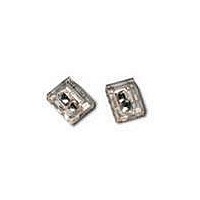AEDR-8300-1K2 Avago Technologies US Inc., AEDR-8300-1K2 Datasheet - Page 2

AEDR-8300-1K2
Manufacturer Part Number
AEDR-8300-1K2
Description
Encoders 2 Channel 75LPI
Manufacturer
Avago Technologies US Inc.
Type
Optical Encoderr
Series
-r
Datasheet
1.AEDR-8300-1K2.pdf
(10 pages)
Specifications of AEDR-8300-1K2
Number Of Channels
2
Mounting Style
SMD/SMT
Supply Voltage
5 V
Operating Temperature Range
- 20 C to + 85 C
Product
Optical
Size / Dimension
3.96 mm x 5.12 mm x 1.63 mm
Technology
Rotary and Linear
Termination Style
Solder Pad
Detents
No
Motion
Linear
Index Output
Not Indexed
Encoder Signal
Digital Square Wave
Built In Switch
No
Operating Supply Voltage (typ)
5VDC
Operating Temperature Min Deg. C
-20C
Operating Temperature Max Deg. C
85C
Sensing Distance
0.079" (2mm)
Sensing Method
Reflective
Sensing Object
Codewheel/Codestrip
Output Configuration
-
Sensing Light
-
Mounting Type
Surface Mount
Current - Supply
2.2mA
Voltage - Supply
4.5 V ~ 5.5 V
Package / Case
5.12mm L x 3.96mm W x 1.63mm H
Features
Compact Model
Lead Free Status / RoHS Status
Lead free / RoHS Compliant
Available stocks
Company
Part Number
Manufacturer
Quantity
Price
Company:
Part Number:
AEDR-8300-1K2
Manufacturer:
AVAGO
Quantity:
50 000
Theory of Operation
The AEDR-8300 series combines an emitter and a detec-
tor in a single surface mount leadless package. When
used with a codewheel or linear codestrip, the encoder
translates rotary or linear motion into digital outputs.
As seen in the block diagram, the AEDR-8300 consists
of three major components: a light emitting diode (LED)
light source, a detector IC consisting photodiodes and
lens to focus light beam from the emitter as well as light
falling on the detector.
The operation of the encoder is based on the principle
of optics where the detector photodiodes sense the ab-
sence and presence of light. In this case, the rotary/lin-
ear motion of an object being monitored is converted
to equivalent light pattern via the use of codewheel/
codestrip. As shown in the diagram below, the reflective
area (window) of the codewheel (or codestrip) reflects
light back to the photodetector IC, whereas no light is
reflected by the non-reflective area (bar). An alternating
light and dark patterns corresponding to the window
and bar fall on the photodiodes as the codewheel ro-
tates. The moving light pattern is exploited by the de-
tector circuitry to produce digital outputs representing
the rotation of the codewheel. When the codewheel is
coupled to a motor, the encoder outputs is then a direct
representation of the motor rotation. The same concept
applies to the use of a codestrip to detect linear motion.
V
CH A
CH B
Figure 1. Block Diagram of AEDR-8300.
2
GND
GND
V
LED
CC
PROCESSING
CIRCUITRY
SIGNAL
R
AEDR-8300 block diag
Definitions
State Width (S): The number of electrical degrees be-
tween a transition in Channel A and the neighboring
transition in Channel B. There are 4 states per cycle,
each nominally 90
State Width Error (∆S): The deviation of state width, in
electrical degree, from its ideal value of 90
Phase (φ): The number of electrical degrees between
the center of high state of Channel A and the center of
high state of Channel B. Nominally 90
Phase Error (∆φ): The deviation of phase, in electrical
degree, from its ideal value of 90
Pulse Width (P): The duration of high state of the out-
put, in electrical degree, within one cycle. Nominally
180
Pulse Width Error (∆P): The deviation of pulse width, in
electrical degree, from its ideal value of 180
Count (N): The number of window and bar pair per rev-
olution (CPR) of codewheel. For linear codestrip, defined
as the number of window and bar pair per unit length
(lines per inch [LPI] or lines per mm [LPmm]).
One Cycle (C): 360 electrical degrees (
one window and bar pair.
CODEWHEE L
OR
CODESTRIP
o
e or half a cycle.
o
e.
o
e.
o
e.
o
e). Equivalent to
o
e.
o
e.

















